This was one river cruise that proved a long time coming. Originally booked in 2019 for a cruise date of October 2020 the rest is history. Intended to be the final chapter in our European river cruising, we had already sailed the Danube, north from Budapest and this south eastern leg had eluded us for some time.

*****

*****

*****
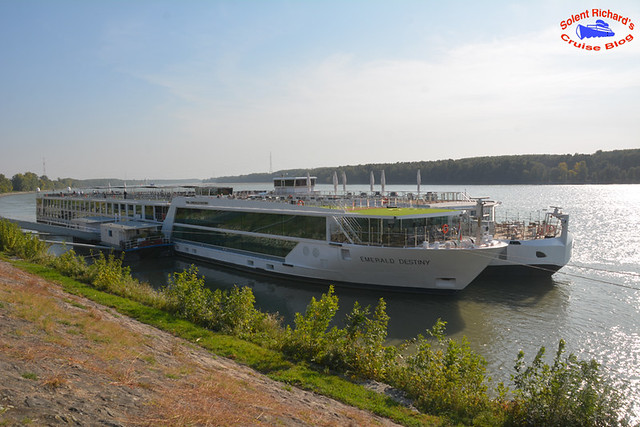
For this river cruise we had booked a Panorama Balcony Suite on Vista Deck, C227…

*****

*****

Emerald’s brochures bill the Panorama Balcony Suites as…
Your Emerald Panorama Balcony Suite offers everything you could possibly need throughout your cruise, and more. You’ll be surrounded by elegant décor and opulent, comfortable furnishings, as you unwind in your home-away-from-home. Relax on your balcony as the stunning landscapes pass by, and transform it from an indoor to an outdoor space with ease, as the floor-to-ceiling window lowers to a halfway point at the touch of a button. Enjoy the river breeze from your comfortable chair, enjoying a good book or the unfolding vistas.
Hmmmm.
Anyway, that’s what we booked and that’s what we had. There was certainly enough storage and innovative desk space…

…while the en suite shower room was pretty standard for river cruise ships…

*****

…There was one particular design feature that I found not to our liking. The door to the ensuite was situated on the left hand side of the bed and rather than being hinged it was of a sliding arrangement. And here’s where that became annoying. The ensuite had a ‘night light’ which easily escaped through the gaps in the sliding door. Had the door been sited in the entrance passage this would not have been the problem it proved.
On a more positive note, we also found in the cabin a pair of very state of the art ‘QuietVox’ Tour Guide Communication Systems…

…which through the cruise proved rather exceptional. More so for yours truly as I rely on these a lot as I wander off on my photographic escapades.
At the heart of Emerald Destiny is the Horizon Bar & Lounge. It is contemporary style social space with a large bar, a hot drinks dispensing area…

…a mixture of comfortable lounge chairs and banquette seating…

*****
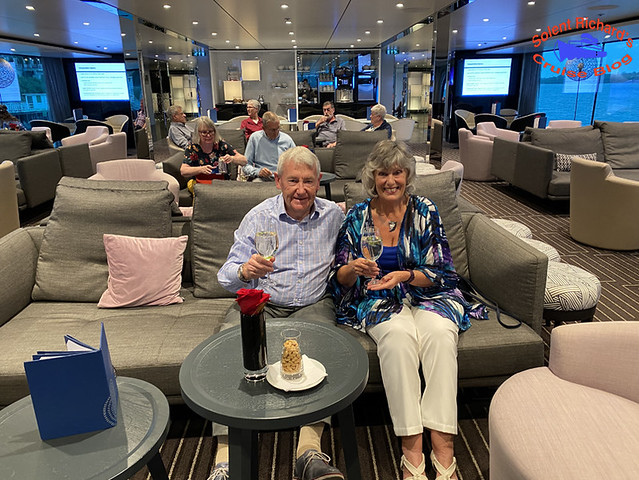
…and a small area in front of the bar ideal for dancing and the occasional local entertainment that came onboard…

The forward end of the bar also serves as the venue for afternoon teas…

*****

Finer weather permitting there is an small additional ‘al Fresco’ area on the bow of the Horizon Deck at The Terrace…

Emerald Destiny’s Sun Deck was quite an impressive space…

…with a sizeable walking track and putting green, sun loungers and shaded seating areas…

…and of course the retractable navigation bridge…

*****

…with adjacent berthing control points on either side…

Destiny also boasts one of Emerald’s Star-Ships signature features, the convertible heated swimming pool with retractable roof that can convert into a night time cinema…

*****

*****
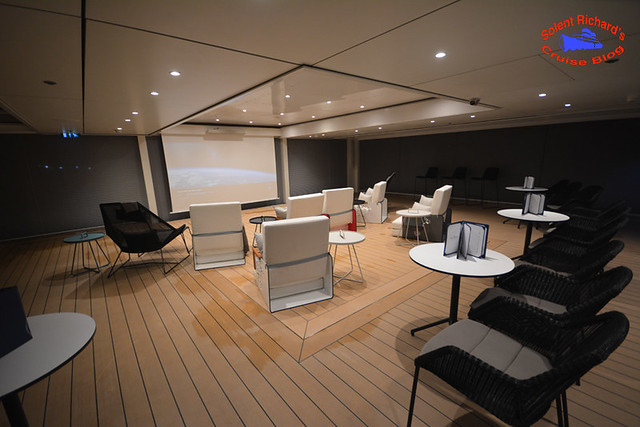
*****

Emerald Destiny’s main restaurant is named Reflections…

Again, it is contemporary in style, design and furnishing. Reflections is open for buffet breakfasts, lunches and in the evening Dinners are four course affairs fully served by waiters.

The breakfast buffet was the usual river cruise fare and style with an egg station…

…and help yourself areas…

*****

For me the standout breakfast option onboard Emerald Destiny was their fresh baked bread offerings…

We found lunches were a bit hit and miss, particularly as we found ourselves arriving late having been on various excursions. However , on two occasions we were more than pleased with the lunch offering

*****

Dinner of course was a much more enjoyable occasion and to our eternal pride we excluded ourselves from the initial rush once the doors opened.
Though choices were more limited than we had previously experienced on river cruise ships, we enjoyed the dinning experience nonetheless.

*****

*****

*****

*****

*****

The Kongsberger Klops…

…and Seared Cod…

Followed by Bananas Foster…

On one evening I chose the Sirloin Steak from the always available ‘Emerald Classics’ section of the daily menu…

….which went well with the Alexis Lichine Merlot …

Emerald Destiny has ninety suites and staterooms which, had full capacity been achieved, could accommodate 180 passengers. On this particular cruise, and for pretty obvious reasons, there were just 69 passengers, a mix of British, American and Canadian passengers.
That concludes, apart from the summary at the end, the physical description of the the ship and how we found it. Let’s move now to the itinerary.
Itinerary

Our original booked itinerary had us flying BA early morning from Heathrow to Budapest. With just over a week to go this was altered to an afternoon BA flight arriving Budapest some 5 hours later than originally scheduled. No big deal for us, we’d done Budapest to death on an earlier Viking cruise.
However once again things did not go according to plan. We were informed by email a week before joining that while our flight from London to Budapest was as programmed our embarkation port was no longer Budapest.
Due to overdue maintenance at the Slovakian Gabcikovo lock complex ….
…we would now be coach transferred from Budapest airport to the Slovakian capital, Bratislava, to embark Emerald Destiny. The coach transfer would take approximately 2 hours.
On arrival at Budapest this had again altered and we were informed we would now be spending a night in a Budapest hotel to join the ship the following day.
The hotel chosen by Emerald was the Barceló Budapest ….

The hotel’s location in Terézváros, the heart of the historic centre of the city, was for us its main attraction. It was surrounded by cafés and restaurants and close to the city’s nightlife, and Emerald had chosen a local restaurant for us to dine in that evening, VakVarju…

…a rather quirky place…
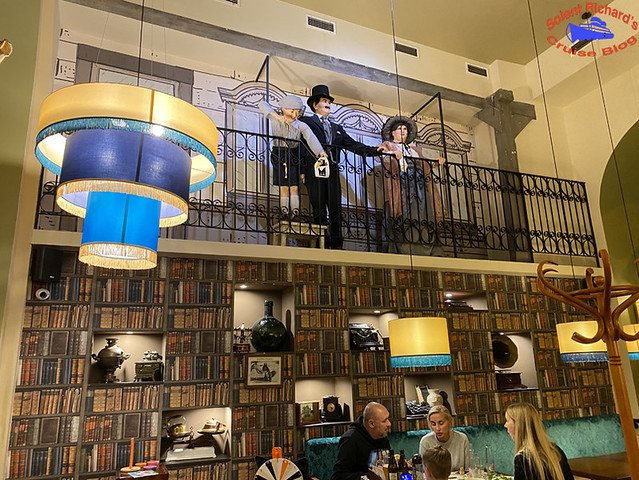
*****

…where we ate and drank well

…despite Emerald volunteering to only foot the bill for one drink per person.
Despite my previous comment regarding doing Budapest to death our post dinner evening exploration returned something that was unavailable on previous visits, The Budapest Eye…

Game on…

*****

*****

*****

Day 2 – Budapest to Kalocsa
The plan for today was to follow the original day’s scheduled excursion by coach and meet up with Emerald Destiny , which was still transiting from Bratislava, at the original port stop for that day, Kalocsa.
Following a pretty poor breakfast buffet at the Barceló Budapest we boarded coaches and set off on the 88 mile (142 Km) trip. Close to Kalocsa we stopped for our planned visit to the Puszta Horse Show …

*****
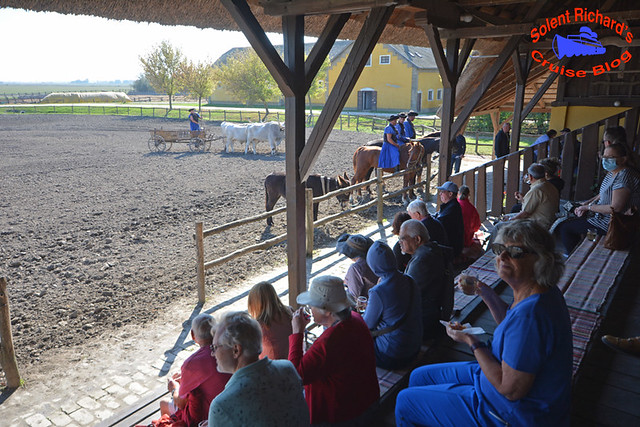
…where we were treated to light snacks and many glasses of the local liqueur. Needless to say I made myself useful, in more ways than one…

*****

*****

******

I would guess, however, that this video conveys a better idea of what’s on offer at the Horse Show …
The show complete we were pretty soon arriving in the town of Kalocsa and the first site of Emerald Destiny berthed there…

Day 3 – Vukovar and Osijek, Croatia
We transited along the Danube between Kalocsa and our next stop, Vukovar, overnight, arriving around 6.30 am. We were now to experience an event that would occur with monotonous regularity for the remainder of the cruise, a Customs and Immigration check. Welcome to Croatia…

Vukovar is Croatia’s largest river port, located at the confluence of the Vuka and the Danube. Due to my interest in military history it was one of the places which attracted me to this particular river cruise.

In the 1991 Balkan war Vukovar became known as Croatia’s Stalingrad when it was the centre of an 87-day siege by Serb militia and the Yugoslav National Army. During that war Vukovar was almost totally destroyed.
In 1998, the city was rebuilt and became a symbol of Croatian independence and resistance: as it remains today.
Today’s Emerald excursion, while giving us an insight into Vukovar, took us some way away from Vukovar: to Croatia’s fourth largest city Osijeck…

Our journey to Osijeck was broken for a visit to the home of a traditional highly entertaining Croat fisherman, Nico, who gave an outstanding personal and humorous insight into his ancestor’s way of life…

*****

(That’s Nico with the net on his shoulder)

…and included a demonstration of traditional Busó legends and festivities…

As with many other stops we were treated to samples of local spirits, wines and small nibbles…

Our next stop was Osijek for a walking tour.
The city was once a major Habsburg military base the Tvrđa (The Citadel) was the largest fortress on the border with the Ottoman Empire.
It is the best-preserved and largest ensemble of Baroque buildings in Croatia and consists of a Habsberg Star Fort built on the right bank of the River Drava. Tvrđa has been described by the World Monuments Fund as “a unique example of an eighteenth-century baroque military, administrative, and commercial urban centre.

*****

The former Tvrđa fortress now houses bars, restaurants and a regional museum. A Hungarian influence can be detected in the local cuisine, in which spicy peppers come to the fore, well illustrated by this restaurants outside Fish BBQ….
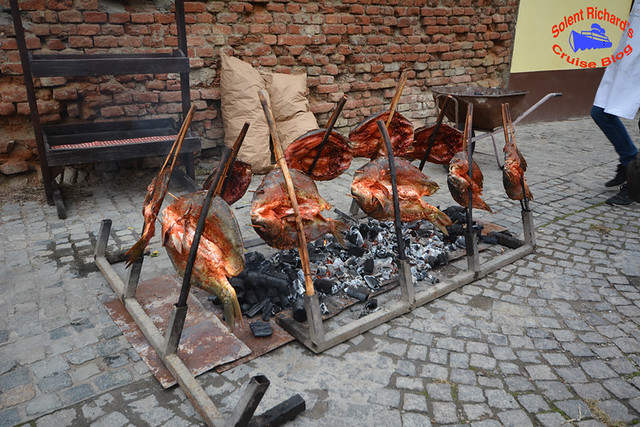
This particular landmark on the main Holy Trinity Square is named the Votive Statue…

It was built between 1729 and 1730 as a thank you for saving, and asking for further protection, from the plague, whose epidemics erupted many times in Slavonia in the 18th century. The statue was funded by Baroness Marija Ana Petraš, who was the widow of the Hussare General, Vice Marshal Maksimilijan Petraš.
In Croatia one is never very far from memorials to the Balkan war. We were shown this particular one in the garden behind the Monastero Francescano della Santa Croce…

…made entirely from munitions recovered after the war…

Our journey back to Vukovar was interrupted by a planned stop at the village of Aljmaš that lies on the right bank of the Danube. As part of Emerald’s Cultural Plus programme we were split into smaller groups to experience a home hosted lunch with a Croatian family….

*****

*****

*****

Before leaving Aljmaš we were given the opportunity to visit a rather unique church, the Marian Church…
During the 1991 Croatian War of Independence the Roman Catholic church of Our Lady of Consolation in Aljmaš was destroyed. It was rebuilt almost completely in 2006…

…and up to 100,000 pilgrims visit the site each 15 August for the the Assumption of Mary.
On our return to the ship there was time for a short break before the final, and for me the most significant, visit of our time in Vukovar. An organised walk to the Vukovar Water Tower and town…

To the naked eye when viewed from the ships berth maybe nothing spectacular or out of the ordinary but this is one of the most famous symbols of Vukovar and the suffering of the city and the country in the Battle for Vukovar and the Croatian War of Independence when the water tower and the city itself were largely destroyed by Yugoslav forces.

On close inspection the areas of damage can clearly be seen…

Following the reintegration of Vukovar into the Republic of Croatia, reconstruction of the water tower was initiated by President Franco Tudman. The process was eventually halted and the tower instead became a memorial area to the pain and suffering that Vukovar endured.
This photograph courtesy of…
https://www.tracesofwar.com/sights/87721/Vukovar-Water-Tower.htm
…graphically illustrates the original level of damage….

On our arrival at the tower I discovered that it was indeed open to visitors. There was no alternative in my mind and I was more than happy to sacrifice the short walk through the town, particularly as sunset wasn’t that far away.
The interior was a veritable labyrinth of walkways…

…with some very detailed display boards illustrating the conflict. There were also numerous places where one could see what internal damage the shelling did…

The roof was actually something to behold and I was so pleased with my decision, especially being able to look across at to where on the Danube our ship was berthed…

…and of course, not being one to miss a photo opportunity, atop with the Croatian Flag…

Later that evening we cast off for our overnight river transit to Belgrade.
Day 4 – Belgrade
Belgrade is the capital of Serbia and one of the oldest cities in Europe and, situated overlooking the confluence of the Sava and Danube rivers is the most visited tourist attraction in Belgrade, Kalemegdan Fortress…
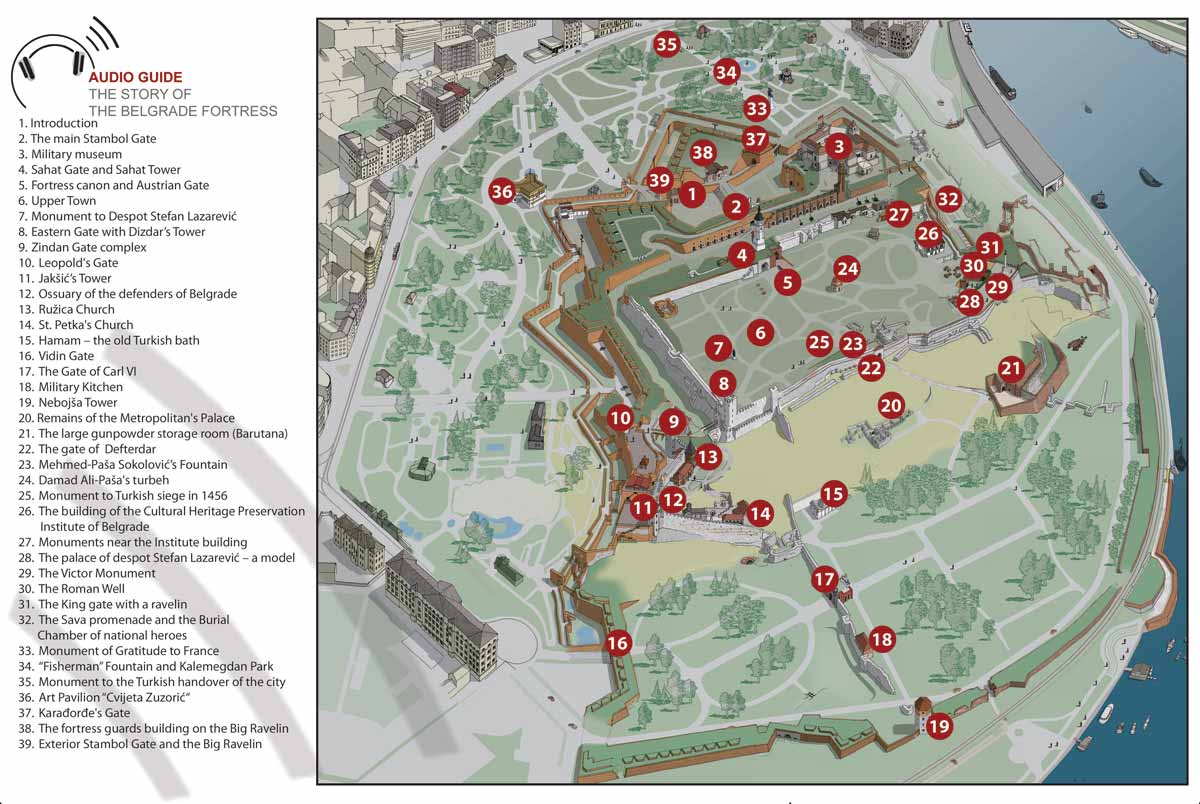
So no prizes for guessing where our first stop on Emerald’s complimentary excursion would be…

Belgrade Fortress is the core and the oldest section of the urban area of Belgrade. For centuries, the city population was concentrated only within the walls of the fortress, and thus the history of the fortress, until most recent times, reflects the history of Belgrade itself…

From the very outer perimeter walls…

…one can gaze over the first Roman settlements…

…including the Metropolitan’s Palace and the site of an Ottoman (Turkish) Hamam.
Indeed, that Ottoman influence is everywhere within the fortresses grounds including Vizier Damad ali Pasha’s Turbeh Mausoleum…
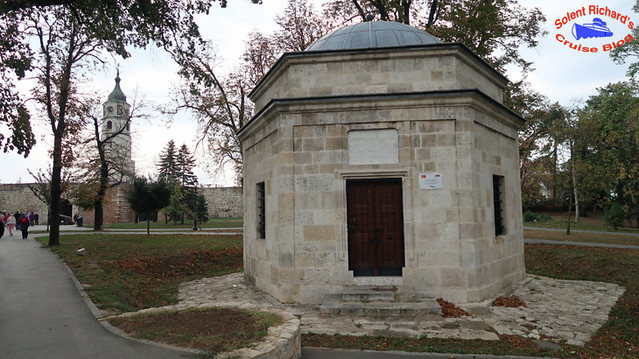
…and the curious Mehmed Pasa Socolovic’s Fountain…

No visit to the fortress would be complete without a closer look at the Pobednik (The Victor) statue at its commanding position overlooking the two rivers…

A popular attraction in modern-day Belgrade, the statue remains one of the most recognized and photographed visual symbols of Belgrade.

The Victor Statue honours the victorious armies of Serbia during their struggles against the Ottoman Empire…
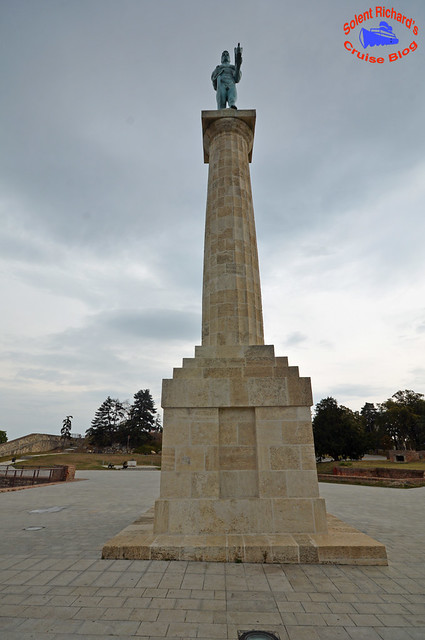
Alas time was of the essence and we were soon back on our coaches heading for the next highlight of our visit, Marshall Tito’s Mausoleum…
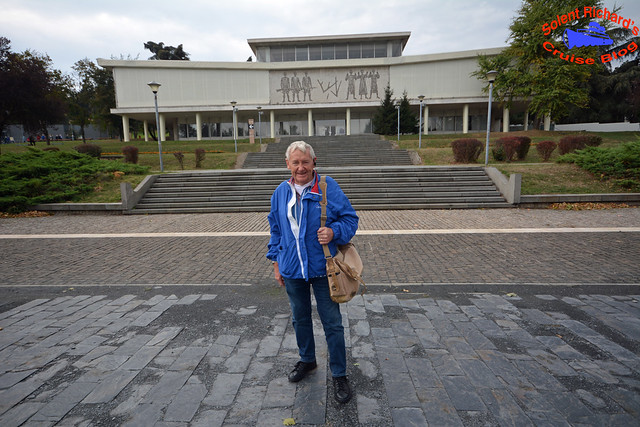
The building is called the House of Flowers and it is amongst an enclosed flower garden that his grave lies….

A large protruding slab of marble with his name in gold marks the spot….

******

Adjacent to the House of Flowers, in a separate building, is a dedicated Museum to the life of Marshall Tito where artefacts of his time in power are on display…

*****

Having completed the visit to Marshall Tito’s Mausoleum our next stop on this excursion was the dominant building over Belgrade, Saint Sava Temple…

Sitting on the Vračar plateau, Saint Sava is a Serbian Orthodox church , the largest Orthodox Cathedral in the Balkans…

Pretty impressive on the outside, internally it was positively stunning…

*****

One could not help but notice the use of the Serbian cyrillic alphabet all around….

On a lighter note on the Cyrillic alphabet, I’ll wager there aren’t many places where one can find a Starbucks named in the Cyrillic alphabet. You can in Belgrade…
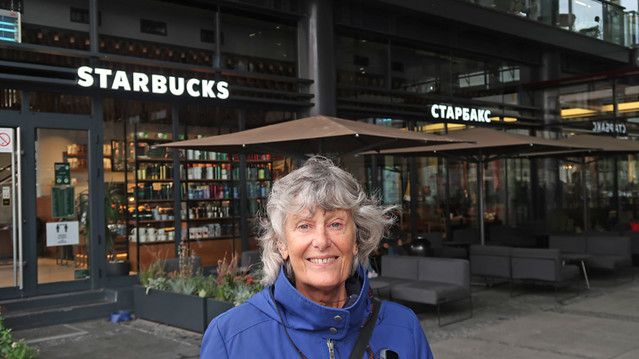
On completion of our visit to Saint Sava’s temple we returned to Emerald Destiny for lunch.
As there was no further guided tours for the day I decided that there were places in Belgrade that I personally would like to take a closer look at. Despite the threatening rain I took the Emerald complimentary shuttle bus as far as the university and, using a touristy street map, plotted a circular route to what took my fancy. Here we go then…
Mansion of Miša Anastasijević University Administration Building…

Prince Mihailo Monument outside the National Museum...

The National Museum…

The National Theatre…

Kneza Mihaila Street – a pedestrian street with classic architecture…

Hotel Moscow….

The Central post Office of Serbia…

National Assembly of the Republic of Serbia Parliament…
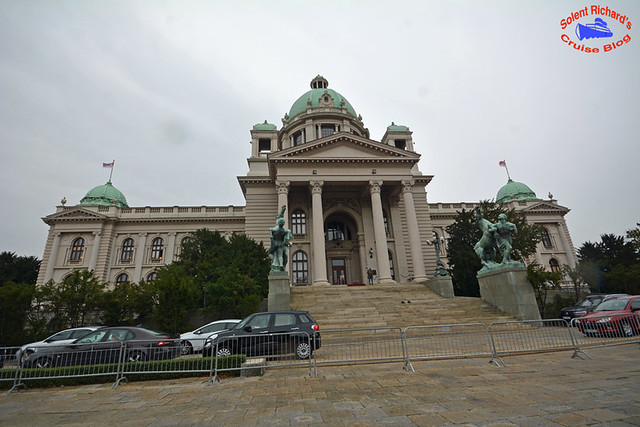
The Old Royal Palace…

Nouveau Palais Seat of President of Serbia…

Ministry of Finance Building on Kneza Milosa…

Serbia Ministry of Defence War Damage on Kneza Milosa…
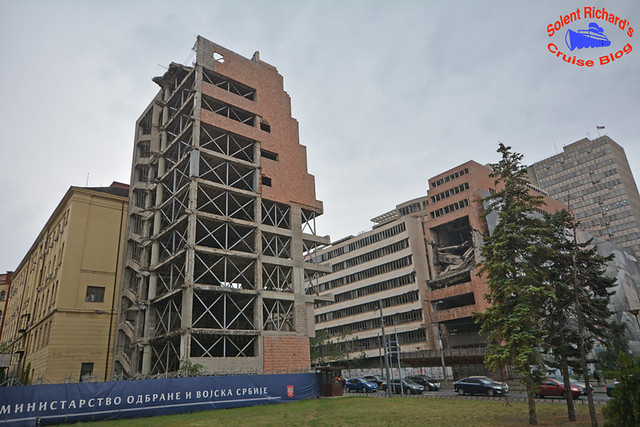
*****

…Belgrade’s most famous ruin. On 30 April 1999 the building was bombed twice by NATO in the space of 15 minutes due to the structure’s significance as a military facility….

Belgrade’s old Railway Station…

*****

…with a Monument to Stefan Nemanja…

…the Grand Prince of the Serbian Grand Principality from 1166 to 1196.
The development of the New Hotel Bristol…
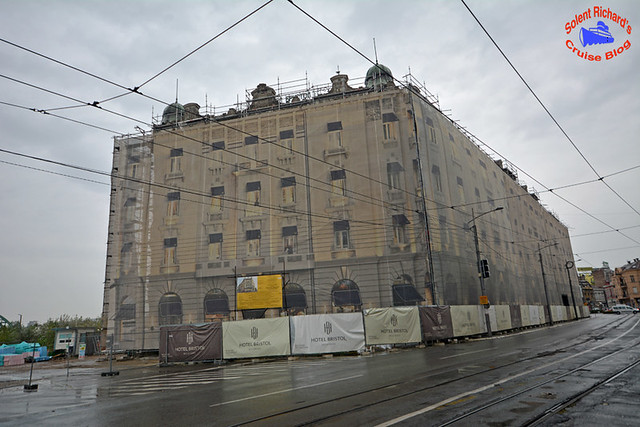
And finally the Geozavod Building – Old Cooperative Bank…
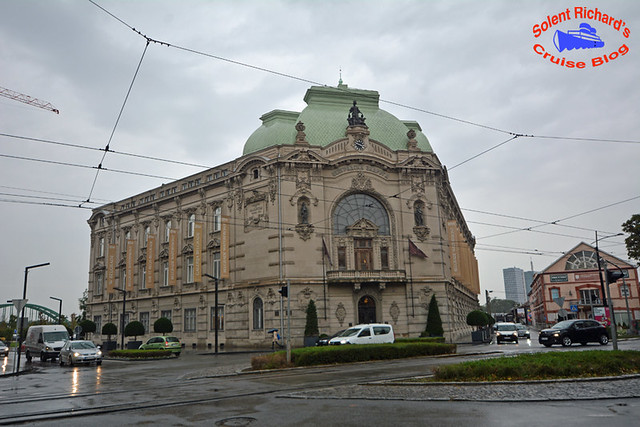
That concluded my circular walk of Belgrade. very pleased I managed every building on my list.
This evening we remained at our berth in Belgrade. There was a degree of planning going on behind the scenes as it had been announced that the weather around the Iron Gates Gorge was not suitable for shallow drafted vessels like river cruise ships. Surely not yet another spoke in the wheel of this cruise.
Day 5 – Belgrade, Viminacium and Golubac
The Daily programme for today offered a simple choice. An excursion coach would be leaving the ship for the Roman Archeological Park at Viminacium at 8.30 or passengers could remain onboard in the hope that the authorities had reopened the ‘sailing stretch’ of the Iron Gates.
The standby plan was for the excursion passengers to either return to the ship at Belgrade, in the event sailing permission was not granted or, in the event it was, their coaches would continue on to the next stop, Veliko Gradiste.
For me it was a no brainer, I chose the excursion while my wife opted to have a lazy day onboard and take pot luck with a sailing.
The coach journey to Viminacium took just over two hours and I was well pleased I’d bagged a front seat for this particular journey.
On arrival at the site, which occupies a total of 450 hectares (1,100 acres), we were allocated local guides with a perfect command of English.
The site contains the remains of temples, streets, squares, amphitheatres, palaces, hippodromes and Roman baths and was once the home of some 48,000 inhabitants. Indeed, so large is the area our coaches were utilised to reach some of the furthest places of interest The visit was well organised with separate groups visiting each site at different times.
Our particular first stop was the site where a replica reconstruction of the cities Amphitheatre had been made on the original Amphitheatre foundations…
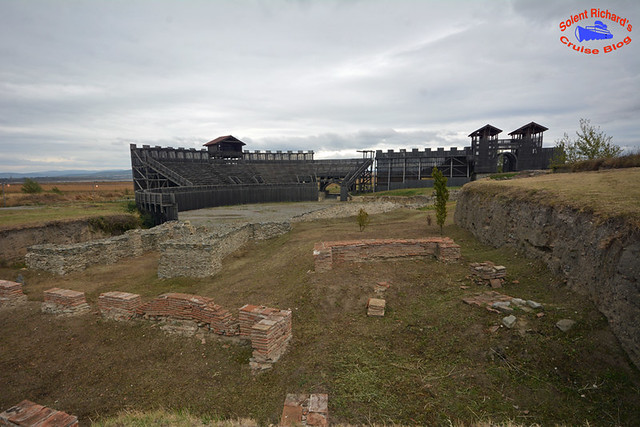
*****

At another part of the site was the Thermai, or Roman Baths…

The baths are distinguished by their architectural design with 5 Conches, 4 of which were ‘tepidoria’ (Warm Rooms) and one of which was ‘afrigidarum ( Cold Room).

…while the heated floor rested on short, brick built pillars…
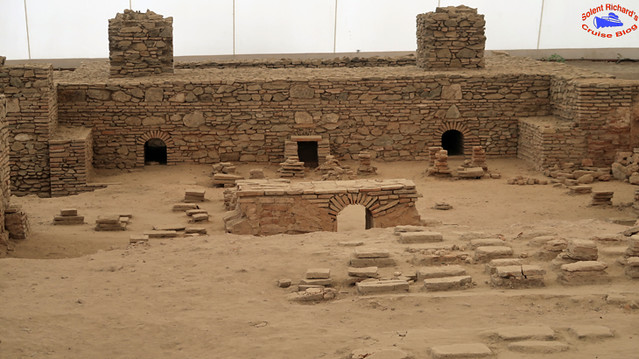
At the site of Pirivoj, on the eastern city necropolis, is the Mausoleum surrounded by a wall…

The central burial chamber and the thick surrounding walls indicate that this was the burial site of a high ranking official. Outside the central mausoleum are many more burial chambers…

As part of the visit we toured the ‘Archeological and Scientific Research Center’, a purpose built authentic reproduction of a Roman villa…

On one level with the centre is a model of antique Viminacium…

…well illustrating the size of the city…

…and its featured buildings…

The final part of our visit to Viminacium was to a covered area that specialised in archeological discoveries in the area. The showpiece of this display was the skeleton of an 800,000 year old Mammoth …
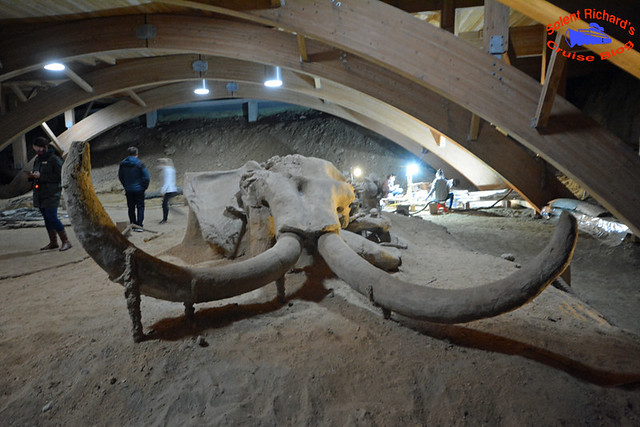
…and the remains of a number of Roman ships that had been excavated in the area…

*****

During my post cruise research I came across an interesting article regarding these preserved Roman ships…
https://arstechnica.com/science/2020/04/probable-roman-shipwrecks-unearthed-at-a-serbian-coal-mine/
While visiting Viminacium we heard the news that Emerald Destiny had sailed from Belgrade and that we were scheduled to join her at Veliko Gradiste following our visit to Golubac.
A point of interest here. On our original booked schedule there was no mention of a visit to Golubac but I had flagged it as a place likely to yield some outstanding photographs as we sailed past. Whether by luck or good fortune, we were now about to physically visit Golubec Fortress, seen here on the approach road……

On arrival at Golubec Fortress reception centre we were offered complimentary snacks and alcoholic drinks; a nice gesture. The view of the Fortress from the Reception Centre…

A short walk and we were exploring the fortifications…

*****

*****

All in all, a pretty impressive place….

Our visit completed we now headed for Veliko Gradiste to rejoin Emerald Destiny and, as we soon were to find out, commence our night time passage through the Iron Gates.
To reach the Iron Gates we first had to pass once more Golubec Fortress. We did this well past sunset which presented an interesting photo opportunity …

*****

Some two hours later we approached the waterside Romanian Mracuna Monastery…

and a few minutes later, the famous rock carving synonymous with the Iron Gates…

…that of Decebalus…

We continued to transit through the night and the following day arrived at the Bulgarian town of Vidin.
Day 6 – Vidin

…which serves as a popular border crossing point between Romania and Bulgaria.
This morning we joined a walking tour of Vidin town which had some interesting places to view despite the intermittent rain. Dominating the town centre was the Saint Demitrius Orthodox Cathedral…
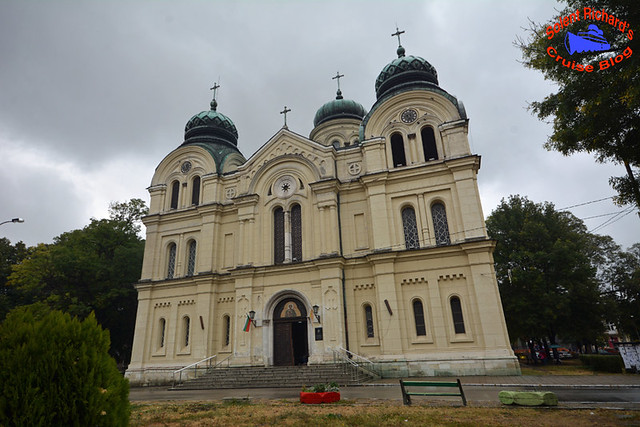
…and this particular monument to the Siege of Vidin when the Serbian Army attempted to seize the Bulgarian city of Vidin during the Second Balkan War in 1913…

*****

Vidin had obviously featured in Bulgarian history. There was a pretty well preserved walled defensive system…

We enjoyed our guided town walk but broke off early when it became apparent that a visit to the Baba Vidi Fortress was not on their schedule. It was relatively easy to navigate there as I’d spotted it earlier as we approached Vidin…

It was just a matter of heading back to the ‘Victims of Communism’ Memorial…

…on the promenade…

…and heading towards the next memorial, the Monument to Freedom…
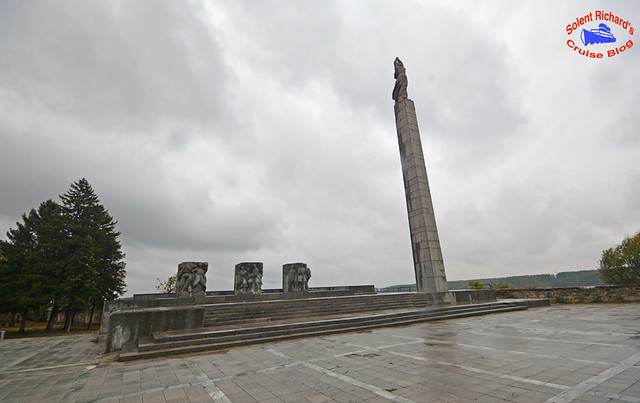
*****

…from where the Baba Vida Fortress was a few hundred yards further…

*****

*****

On our return journey we made a very small detour in order to take in what appeared to be an interesting building. It turned out to be an abandoned Synagogue…

…once noted as the second largest Jewish temple in Bulgaria…

Built in 1894, it fell into disuse after the majority of the local Jews left Bulgaria during and soon after World War II.
The synagogue was then seized by the communist government, and during the 1970’s, the Ministry of Culture and the National Institute of Monuments developed a plan to restore the building. However, when the communist regime collapsed in 1989, the project was abandoned, leaving the synagogue roofless and exposed to the elements.
We returned to Emerald Destiny for lunch and to prepare for the afternoon excursion, one of two on offer. We had chosen to take the one heading to Belogradchik Fortress…

…an ancient fortress located on the northern slopes of the Balkan Mountains and close to the north western town of Belogradchik. It is the town’s primary cultural and historical tourist attraction and, along with the Belogradchik Rocks, accounts for the main flow of tourists into the region. It is one of the best-preserved strongholds in Bulgaria and a cultural monument of national importance…

Luck, in the form of weather, wasn’t wholly with us, and while the hour and a half journey proved interesting, the rather damp weather generated an irritating cloud formation over the rock formations that usually form such a splendid backdrop.

Undeterred however, we weren’t going to be beaten and proceeded to make the climb to the top…

*****

We made it….

*****

One can only imagine what the view would have been like on a clear day…

On our return to the Emerald Destiny she wasted no time in getting underway from Vidin as we headed overnight for our next stop, arriving in time to capture the early morning sunrise over Rousse…

Day 7 – Rousse
After a little jockeying to get onto our berth…

…there were two excursions on offer today. We had chosen the one that would take us to the historic mountain village of Arbanasi which is perched on a plateau overlooking the Yantra River and the equally impressive clifftop town of Veliko Tarnovo – once the former capital of the Bulgarian empire
This was again a very long coach ride, just in excess of 2 hours. Fortunately Emerald had arranged a good comfort and complimentary refreshment stop at an hotel in Arbanasi…

Refreshed from our earlier journey we were taken on a walk through this very attractive and popular Bulgarian tourist destination. There was a stop at a local souvenir shop…

…and another tasting of the local wines…
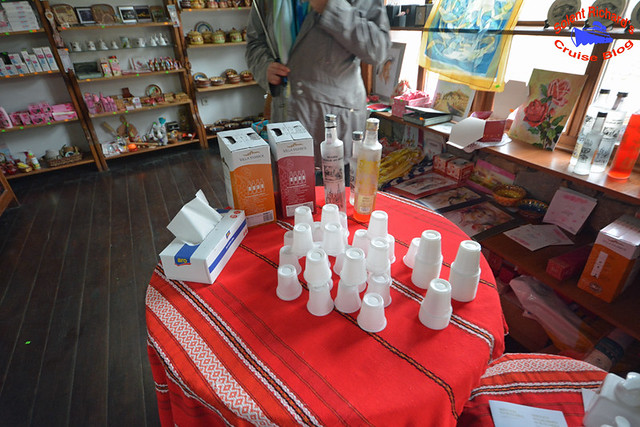
My wife found this particular shop most beneficial. It was one of the few specialist retailers who sold Bulgarian ‘Rose Petal Jam’. We could not resist purchasing two jars…

The main stop of our visit was, however, the Church of Holy Archangels Michael and Gabriel…

…The church appears very modest from outside but inside it is quite spectacular with impressive wall-paintings and murals. Of particular note are the images of the female saints painted against starry sky.

The wood-carved iconostasis was made by painters from the Art School in Tryavna.

While visiting the church we were treated to a pre-arranged Choir performance of acapella style chants and hymns…

While on our village walk our guide pointed out an impressive gateway. She explained that this was the entrance to the Arbanasi Palace Hotel which, prior to its change of use had been the residence of the Bulgarian dictator, Todor Jivkov…

(more about this later)
Our vist to Arbanasi now complete we headed to our next stop, Veliko Tarnovo…

…and the Tsarevets Fortress that dominates the centre of the old capital…

Tsarevets Fortress is a medieval stronghold located on a hill of the same name in Veliko Tarnovo. It is some 206 metres (676 ft) above sea level. It served as the Second Bulgarian Empire’s primary fortress and strongest bulwark between 1185 and 1393. It additionally houses the Royal and the Patriarchal Palaces and is a most popular tourist attraction…

*****

To recall the earlier photograph from Arbanasi, our guide could now point out the dominance and commanding position of dictator Todor Jivkov’s residence: now the the Arbanasi Palace Hotel…

…and with a little bit of camera zoom….

The five-star Arbanassi Palace hotel is perched on the crags above Veliko Tarnovo with phenomenal views of the city and the surrounding hills. What makes it unique among luxury hotels in the country is that it was originally designed and built as a residence for the People’s Republic of Bulgaria’s Head of state.
On our return to Rousse we made an early evening short Danube crossing to the Romanian left bank and the port of Giurgiu: indeed, Giurgiu was almost directly opposite our previous days berth at the town of Rousse…

The sole purpose of being here is the convenience of the port to the Romanian capital, Bucharest where we would travel on disembarking Emerald Destiny after breakfast the following morning.
Day 8 – Giurgiu to Bucharest
I did wonder if we were at the right place, or certainly the correct pier when while walking along the sundeck before breakfast I spotted an old favourite of ours, Viking signage and coaches…

*****

*****

It was no mirage and we we were soon to discover it was Emerald who were sharing the Viking berth and that Emerald had hired local coaches for our transfer from Giurgiu to Bucharest.
The daily programme and the cruise director’s previous evening briefing had offered a reasonably straight forward routine for disembarking. There was however a little annoyance when, with a full lounge waiting, the order for disembarking appeared to the cruise director’s favourite group and not to those who had arrived first in the Horizon Lounge.
Once on our way the journey to Bucharest took just short of 2 hours but that did include a welcome ‘comfort stop’.
Our guide Vadim kept us well informed of facts and information as we journeyed. From one such snippet we learnt that in Romania the indigenous ‘Roma’ were as big a problem in Romania as they are in the UK. Here’s one of their garish homes that we passed…

We were soon to be made aware that we were entering the Romanian city as we drove past a number of grand statues and landmarks including the Arcul de Triumf…

…dedicated to the War of Independence and World War I.
…and the ‘Eroilor Aerului’ – Monument to the Heroes of the Air – dedicated to the airmen heroes of WWI…

Our first stop on arriving in Bucharest was Casa Ceausescu …

Nicolae Ceaușescu was the General Secretary of the Romanian Communist party from 1965 to 1989, and the second and last Communist Leader of Romania. Also known as the Spring Palace, the Ceaușescu Palace is a luxurious building where Ceaușescu and his family lived between 1965 and 1989. The Palace is surrounded by 14,830 square meters of land.

On arrival we were allocated a dedicated Palace guide who proved both exceptionally knowledgeable and wickedly humorous.

*****

The full tour took an hour and a half and included almost every room. One could not help being struck by the opulence and extravagance of the fixtures and fittings on display in this 80-room former residence of Romanian president Ceausescu…
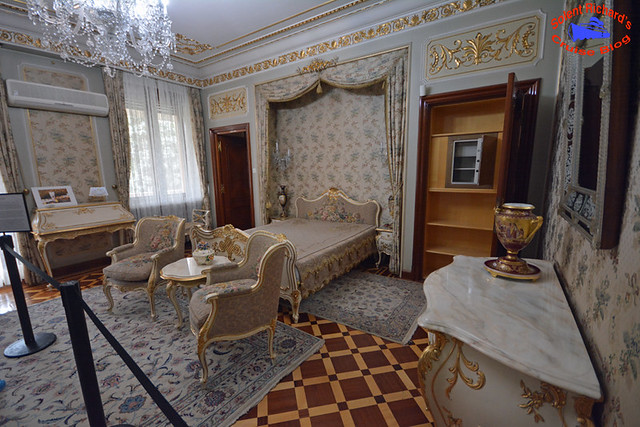
*****

On a higher floor there was a ‘Winter Garden’…

*****
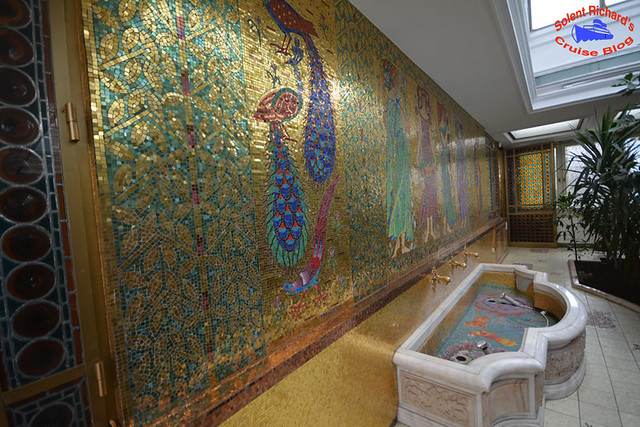
While on the ground floor was the indoor swimming pool…

The tour and our brilliant guide certainly kept us entranced at the lifestyle this guy had while his country suffered abject poverty. By the end of our tour we were definitely of the impression that the Palace in its ‘Museum’ format is most certainly doing the job the Romanian government intended.
On completion we took another short coach tour to the area of Bucharest known as the ‘Old Town’. Here we were to be given free time and for those who wished lunch at their own expense. In preparation for our Bucharest visit we had researched a number of sights that we thought would be of interest to us. As luck would have the walking route between our coach drop off and the centre of the ‘Old Town’ took us within touching distance of the second sight on our list, Stavropoleos Monastery…

An Eastern Orthodox monastery for nuns it was built in Brâncovenesc style.

One of the monastery’s constant interests is Byzantine Music, expressed through its choir and the largest collection of Byzantine music books in Romania.
The first tourist sight on our list a was the Parliament Palace, renowned as the second largest building in the world. We had however been promised by Vadim that our coach would take us to view that particular sight after our free time.
Quickly establishing our bearings we now headed for Piata Revolutie or Revolution Square.
In front of the Romanian Ministry of Internal Affairs is the Memorial of Renasteril….

…or translated reads Memorial to Rebirth. On the opposite corner can be found the Central University Library Building…

…with the equestrian Statue of King Carol 1st dominating its entrance…

…while on the opposite side of Calea Victoriei is the a very grand building, the former Royal Palace and now the National Museum of Art…

A short distance across the square can be found the Arteneul Roman Neoclassical Concert Hall...
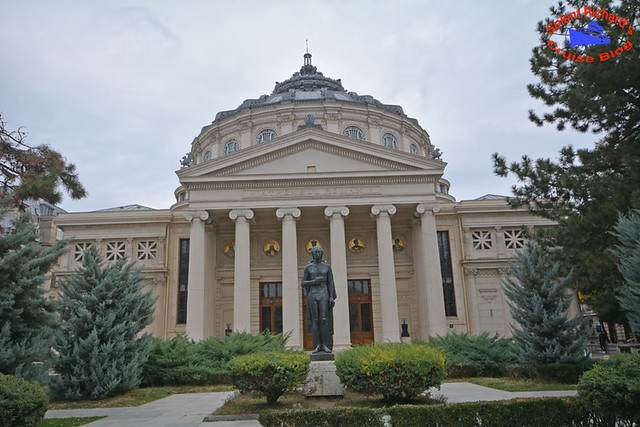
Time to head back to our meeting point but not before we discovered, just past the Museum of Art, this other little gem…

Kretzulescu Church is an Eastern Orthodox church, again an example of the earlier mentioned Brâncovenesc style of construction.
On our return journey we also passed the rather iconic Odean Theatre…

…and this amazing sculpture outside the National Theatre, entitled The Cart with Harlequin…

*****

Finally, before meeting up with Vadim…

…we discovered this glorious covered arcade complex…

…which we christened ‘Shish Alley’ due to the nature of the cafes on each side…

Prior to embarking the coach we squeezed enough time for a few Romanian beers…

Vadim was true to his word the coach took us to see that amazing building, Bucharest’s Palace of Parliament…
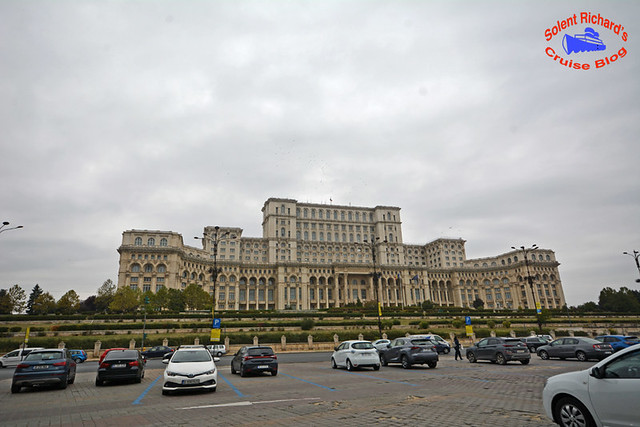
…with just enough time for a personal photoshoot…

before we headed off to our hotel for the night, The Radisson Blue…

There is one more significant memory that we had in Bucharest. Acting on our guide Vadim’s advice, we ventured out that evening and made a fantastic discovery of a restaurant maybe just 15 minutes walk from the hotel. On a street, Strada Nicholae Golescu, directly behind the Romanian Athenaeum Concert Hall, were a collection of renowned restaurants. As luck would have it, and aided by a little rainfall, we chose Caju…
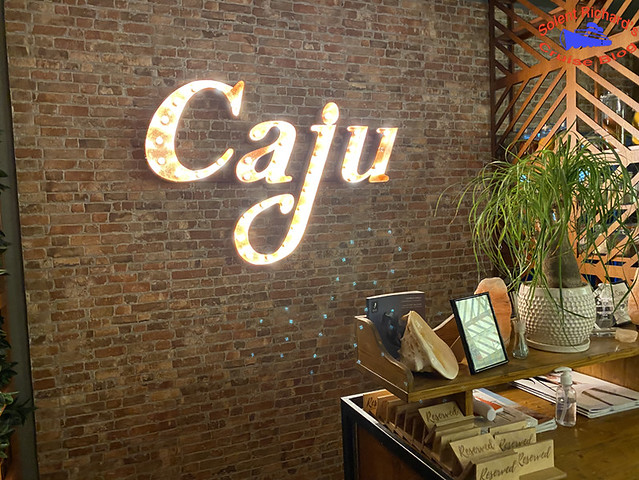

.


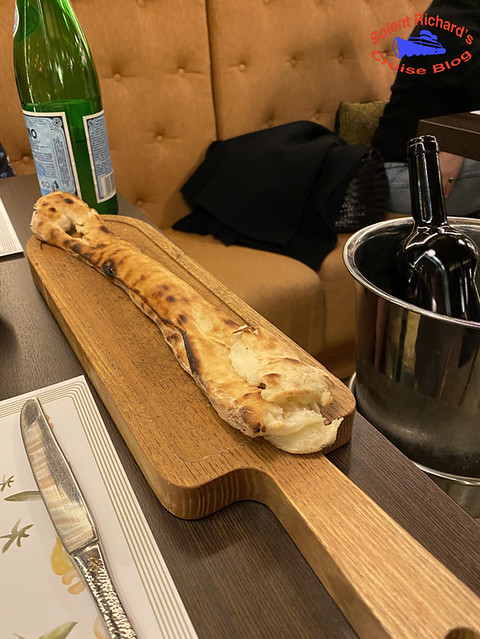
Starting with a grilled Calamari Salad…

…followed by the main course, Saint Jacques and Shrimp Ravioli Duet…

Having thought those two courses were sublime we were really wowed when the desserts appeared…

A closer look, my ‘New Style’ Mille Feuille …

…and Barbara’s Pistachio and Caramelised Cashew Nut Halvah Parfait…

One memorable meal up there with the best we have experienced worldwide.
The following morning we were transferred to Bucharest International Airport for our flight home. Supposedly due to covid restrictions our previously scheduled late afternoon direct BA flight to Heathrow was replaced with a mid morning Lufthansa flight via Munich – effectively curtailing any further Bucharest photography. A small price to pay.
Summary
Writing a fair and meaningful summary was always going to be a tall order when there was so many restrictions imposed at this time. We were always willing to offer Emerald a degree of sympathy for what must have proved a logistical nightmare. However, leaving covid aside, there were two other ‘unforeseen’ elements that played a part in changes to our programme that were generally disappointing.
The first was the problems at the locks between Bratislava and Budapest resulting in the non availability of Emerald Destiny at Budapest for our arrival. We were informed of the problem some 7 days prior to our departure from UK and, out of curiosity, I researched the lock. That research revealed that the EU’s project Upgrade of the Gabčíkovo locks commenced on 20 June 2019. So this was certainly not a recent problem and to have a ship the wrong side would appear to be the result of some bad logistic planning.
The next ‘spanner in the works’ was the weather. Fine, we have no issues with sailing European rivers in October: there is a financial benefit but when the weather caused the Bulgarian authorities to block our sailing through the Iron Gates, that impacted on two particular items on the itinerary: the cancellation of the stop at the Palaeolithic site of Lepenski Vir and a daylight passage through the Iron Gates and in particular, past the famous rock carving of King Decebalus.
Emerald did organise an alternative ancient settlement site visit as I’ve described in the itinerary section at Day 5. Of course, we will never know what we missed by not visiting Lepinski Vir.
A further plus note comes in the form of transiting the Iron Gates at night. We did end up taking some rare photographs of the floodlit Gu Fortress and the Decebalus rock carving.
Which brings me to an issue that had bugged me for some time. Emerald and other cruise lines that navigate this section of the Danube have a habit of using a false photoshopped photograph in their promotional advertising and brochures…
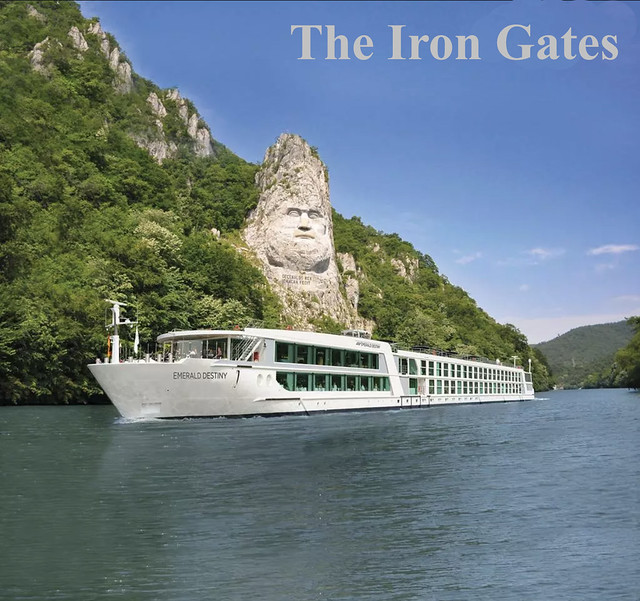
But the reality is (courtesy of Google maps) that river cruise ships cannot sail that close under the carving as displayed: there is a bridge between the main Danube river and the small Romanian tributary, The Mraconia, which precludes them getting that close…

Overall we found the food reasonable. There was definitely less choices at dinner than we have experienced on other river cruises while fortunately there were some good lunch main courses on offer to supplement the more monotonous ‘Daily Pasta’ station.
Also on the plus side the all Inclusive drinks package was a good addition though it was obvious not all passengers had been included in this booking offer. The crew were particularly good as well though one does wonder whether this was in part due to the reduced numbers sailing – 69 on board as opposed to 180 under normal circumstances. Sadly we’d heard that only 46 were scheduled for the return sailing to Budapest.
So we did enjoy our experience and got to see the majority of places on the itinerary that we hadn’t previously visited.
Two final points. Would we sail with Emerald again? The answer is probably not. We have sailed with her big sister Scenic and there is a massive gap in the quality of the experience. Secondly, and this is for anyone considering the itinerary – best advice would be to pick the more expensive mid-season months with a better chance of finer weather and, if you have that extra cash, go for a longer itinerary, say the 11 or 14 day ones and guarantee the additional time to enjoy some time on the river itself.


Thanks Richard. I am cruising with Emerald in August on the Rhine/Moselle. Have got the same category of cabin so interested to read your comments. Hopefully things will be back to some kind of normality by then! Best wishes to you and Barbara!
Outstanding photos and reviews!!
Impressive blog as usual by you.both and you can travel while we are still COVID locked
Blessings
Fascinated to find you here Richard. I’ve previously only seen your comments and photos on a chat page on a British Travel site to which I used to contribute. Covid must have thrown an enormous spanner in the works for your lifestyle. I’m not a cruiser but have a very good friend, recently widowed, who is taking this cruise, or something very similar, with his son at the present time. It will be bittersweet for him as he and his wife had similarly traveled the world together.
Wonderful, thank you.
Thank you for this detailed and interesting account of your trip
Thank you for the interesting and detailed coverage of your trip